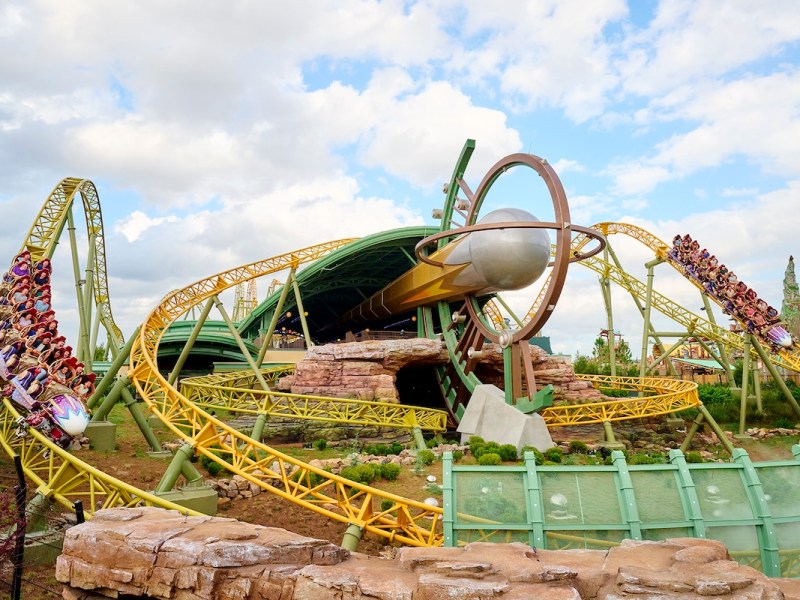After collecting millions of dollars in revenue from drivers who illegally ran red lights over the last year, Orlando City Council on Monday will consider a significant expansion of its red light camera program for more than four dozen intersections the city has flagged as hazardous.
According to city documents, the city currently has 45 traffic infraction detectors (i.e., red light cameras) set up at 25 intersections across the city. Most are concentrated downtown, representing less than 5 percent of the more than 500 intersections within city limits.
The intersections where cameras have been set up have been identified as particularly dangerous, based on collected crash, injury and fatality data.
As part of the city’s “Vision Zero” plan, launched with a goal to eliminate traffic fatalities by 2040, the city is now looking to kick the program up a notch, according to City Council’s Monday meeting agenda.
Under a proposed expansion, subject to a public hearing and approval by Orlando City Council, the city will add an additional 55 cameras at intersections identified as dangerous through a study conducted by the city.
“The red-light cameras are only installed at intersections where data has shown a heightened safety risk,” a city report reviewing last year’s data reads. “The risk of traffic incidents includes a frequency of right-angle collisions, also known as T-bone collisions. These types of crashes cause the most injuries and sometimes death depending on several factors, most importantly the vehicle’s speed on impact.”
Potential targets for the new cameras include multiple intersections along Colonial Drive (including the no-left-turn Colonial and Mills Ave), and several intersections on John Young Parkway and Kirkman Road, among others.
Running a red light in Orlando — at least at an intersection with a camera already in place — is costly. Under the camera program, drivers who run a red light receive a violation notice mailed to the address associated with their vehicle’s license plate that includes the date, time and location of the violation, assessing a $158 fine that’s due within 90 days.
Failing to pay the fine can lead to a uniform traffic citation — resulting in an even steeper fine of $262, plus other potential penalties for failure to pay. Violation notices include a link to view camera footage of the violation online. The program also offers the opportunity to contest the fine, if you’re willing to go to court. There are no points added to your driver’s record, as long as you pay the fine on time.
Cashing in
Orlando’s red light camera program, first launched in 2008, is similar to programs in neighboring municipalities such as Orange County, Maitland, Winter Park, Kissimmee and Ocoee. And records show it’s fairly lucrative.
According to city documents, Orlando issued more than 60,000 violation notices to drivers from July 1, 2024, to June 30, 2025, and issued 20, 412 uniform traffic citations for unpaid fines — collecting a whopping $7.6 million in revenues total, split between the city and the state government.
Documents show that the city collected $4.2 million from that split, with $3.4 million distributed to the state. The state then distributes that revenue to hospital trauma centers, the spinal cord and brain injury state trust, and the Florida Department of Revenue, according to city documents, while the city’s share of funds largely go toward financing traffic safety projects.
“All revenue collected from Red Light Camera notices and citations goes directly into the City’s Vision Zero Traffic Safety Fund, which is dedicated to eliminating traffic deaths and serious injuries by enhancing roadways and reinvesting in safer streets for everyone,” a city spokesperson told Orlando Weekly in an email.
Under a state law (HB 1363) approved by Florida lawmakers last year, in part to rein in these programs, cities like Orlando that wish to install additional enforcement cameras “must determine that the intersection at which a traffic infraction detector is to be placed or installed constitutes a heightened safety risk that warrants additional enforcement measures.”
That’s why the city conducted a study on this (albeit not an independent one) — officials wanted to substantiate the need for additional cameras. “Our goal is to reduce deadly and serious injury related crashes caused by red-light running (RLR) throughout the city,” transportation planner Michael Greco and civil engineer Andrew Panek wrote in a July 25 memo to city department of transportation director Tanya Wilder on results of the study.
Do red light cameras make communities safer?
Officials have said the program isn’t meant to be punitive, but rather to deter repeat and future violations and help prevent dangerous collisions involving motor vehicles, pedestrians and bicyclists.
Still, this kind of program has seen its share of controversy, facing legal challenges and safety benefits questioned by critics. Florida lawmakers have also in the past sought to get rid of the state statutes that allow cities to set up these programs in the first place.
“Cities should not be financing their entire budgets off of these systems,” Republican Rep. David Borrero of South Florida argued last year, as a sponsor of a bill that sought to allow a statewide ballot measure giving voters the chance to ban the programs themselves. “To have to ticket people to death in order to exist as a municipal government in my opinion is inappropriate,” Borrero said.
As the Florida Department of Highway Safety and Motor Vehicles noted in a December 2024 report, there is no state oversight of these camera programs across Florida; however, they say they’re able to determine which jurisdictions “potentially” run these programs, based on money that’s deposited into the state Department of Revenue. The new law approved in 2024 also now requires municipalities to produce reports about their programs annually. The FHSMV has counted at least 38 of them total.
Most of the municipalities that operate these programs, including Orlando, admitted to the FHSMV last year that they have not conducted an independent analysis of their programs — presumably, to determine their actual effectiveness and impact.
Data submitted to the FHSMV, however, covering the 2023-24 fiscal year, doesn’t exactly support a reduced number of crashes, nor reduced injuries, from the installation of red-light cameras.
Almost all crash types, including rear-ends, actually increased after cameras were installed, according to the state report. Serious injuries and incidents of property damage similarly increased after installation, while fatalities remained steady and the number of non-serious injuries decreased slightly.
The city of Orlando did not return our request for comment on these findings ahead of publication. City staffers involved in Orlando’s program have in the past argued that the numbers don’t tell the full story. “Some of these crashes have nothing to do with the signal,” said program operations manager Ray Rodriguez in an interview with WESH-2 last year.
Orlando’s red light program, like more than two dozen others in the state according to the state report, is managed through private contractor Verra Mobility (formerly known as Laser Craft). According to city spokesperson Ashley Papagni, Verra Mobility — not the city — will cover the purchase of the cameras, which cost an estimated $71,000 each.
The vendor, of course, also benefits from this agreement. “The vendor begins receiving revenue only after the cameras are active and operational — essentially, the city leases the cameras from the vendor,” Papagni explained. She did not clarify how much revenue the vendor ultimately receives.
Currently, according to fiscal impact documents, the plan is to get at least 35 more cameras purchased and operational by springtime next year. The agreement between the city and Verra Mobility is scheduled to go before Orlando City Council on Oct. 6, 2025. The vendor is expected to begin pulling permits in mid-October, according to Papagni, with camera installations anticipated to be completed by spring 2026.
Subscribe to Orlando Weekly newsletters.
Follow us: Apple News | Google News | NewsBreak | Reddit | Instagram | Facebook | Bluesky | Or sign up for our RSS Feed
Related
Source link



